24 Hours in Buenos Aires
 It is 1 am in Buenos Aires, which means I've now enjoyed my first 24 hours here. They have not been wasted, except for one of them, but even that one gave me a story to tell. The flight from Rio, on Varig, arrived on time at midnight. The procedures for immigration were efficient and painless, as the line was not long, and as Americans do not need a visa for tourist visits. I picked up my bag, got out my winter coat, and walked to customs. I was selected for my bags to be searched, but I just had to put them through the xray machine, and that was it. I was met outside by Eduardo, a tall and elegant man who speaks impeccable English (as well as four other European languages) and who has worked for many years in the travel industry. I learned that he loves travel, and is a great fan of classical music--symphony and opera. He is an enthusiastic supporter of the Teatro Colon, which he tries to attend at least once a week when he is at home in Buenos Aires.
It is 1 am in Buenos Aires, which means I've now enjoyed my first 24 hours here. They have not been wasted, except for one of them, but even that one gave me a story to tell. The flight from Rio, on Varig, arrived on time at midnight. The procedures for immigration were efficient and painless, as the line was not long, and as Americans do not need a visa for tourist visits. I picked up my bag, got out my winter coat, and walked to customs. I was selected for my bags to be searched, but I just had to put them through the xray machine, and that was it. I was met outside by Eduardo, a tall and elegant man who speaks impeccable English (as well as four other European languages) and who has worked for many years in the travel industry. I learned that he loves travel, and is a great fan of classical music--symphony and opera. He is an enthusiastic supporter of the Teatro Colon, which he tries to attend at least once a week when he is at home in Buenos Aires.As the taxi reached downtown well after midnight on a Sunday night, it was apparent that many people were out dining in restaurants, and the streets were not at all empty of cars and pedestrians. New York is not the only "city that never sleeps." It reminded me of the very rich and very late nightlife of the city. Buenos Aires shares a late night dining, strolling, and dancing culture that one also finds in other great cities of the Latin world, notably Rome, but especially it seems to me Madrid and other large cities of Spain. The taxi turned onto Las Heras, and I realized that my lodgings would be close to my good friend Leandro, the editor of Gourmet Musical. My destination was in fact only 5 blocks from his apartment. (I knew it was in Palermo, but I was not sure exactly where). When I arrived, it was after 1 AM. My friend Charles, from whom I'm renting a room, was of course up and waiting for me. I decided that 1:30 AM was not too late to call my friend Leandro, who was also of course up and working on one of his projects. Charles and I stayed up chatting until about 3 AM, when we decided it was time to retire, since I had my first dance class in the morning. (Actually bedtime was an hour later for having gotten locked into the bathroom and occasioning the visit of a chavero at 4 in the morning...that's the hour that I could have done without!).
I got up at around 8:30 (AM).
 I am in a comfortable room with a queen bed with a nice firm mattress. I had a good four hours sleep. The morning sky promised a lovely day. I opened the window and two flamenco dancers seemed to smile at me from the tiled courtyard in the back (the photos here don't show the smiles--but if you woke up on a sunny day in August in Buenos Aires with the prospects of two weeks of simply dancing tango, valse, and milonga, you would see the smile, too; or perhaps they just don't smile when being photographed...). Charles' friend A. prepared tea and also went out and rounded up some medialunas (croissants) for breakfast. At 11 AM, I took the bicycle that Charles has so generously made available to me, and rode a couple of kilometers to Santos Dumont and Cordoba, where my first tango class was to start at 11:30.
I am in a comfortable room with a queen bed with a nice firm mattress. I had a good four hours sleep. The morning sky promised a lovely day. I opened the window and two flamenco dancers seemed to smile at me from the tiled courtyard in the back (the photos here don't show the smiles--but if you woke up on a sunny day in August in Buenos Aires with the prospects of two weeks of simply dancing tango, valse, and milonga, you would see the smile, too; or perhaps they just don't smile when being photographed...). Charles' friend A. prepared tea and also went out and rounded up some medialunas (croissants) for breakfast. At 11 AM, I took the bicycle that Charles has so generously made available to me, and rode a couple of kilometers to Santos Dumont and Cordoba, where my first tango class was to start at 11:30.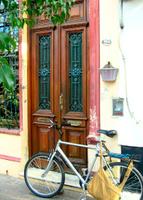 I love riding bikes in big cities, and I had not really had the chance to do this since the time I commuted daily by bike from Windsor Terrace in Brooklyn to mid-town Manhattan back in 1993 (when I was working on Alan Lomax's "Global Jukebox" project). This was a perfect day to bike in Buenos Aires. It must have been around 50 degrees outside, and the streets were practically empty of traffic, because today is a national holiday (I haven't learned which one, but banks were closed, and the city was quiet). Although treacherousness is part of the thrill of riding bikes in busy and pot-holed cities such as New York and Buenos Aires, I'll definitely have to be much more careful on my rides beginning tomorrow, when traffic should return to its normal state of chaos. I've been warned to especially watch out for the taxis and buses.
I love riding bikes in big cities, and I had not really had the chance to do this since the time I commuted daily by bike from Windsor Terrace in Brooklyn to mid-town Manhattan back in 1993 (when I was working on Alan Lomax's "Global Jukebox" project). This was a perfect day to bike in Buenos Aires. It must have been around 50 degrees outside, and the streets were practically empty of traffic, because today is a national holiday (I haven't learned which one, but banks were closed, and the city was quiet). Although treacherousness is part of the thrill of riding bikes in busy and pot-holed cities such as New York and Buenos Aires, I'll definitely have to be much more careful on my rides beginning tomorrow, when traffic should return to its normal state of chaos. I've been warned to especially watch out for the taxis and buses.
A woman let me into the dance studios, where flamenco is taught as well as tango, and probably many other dances, too. The studios are in a charming old home with a courtyard, tiles, brick and metal work, and high ceilings, typical of Buenos Aires (and owing much to Spanish architectural style). My friend Charles had made the arrangements for my study, over the next two weeks, with three different instructors at two different studios, both of which are located in the Palermo district. (I explained in a prior post that it was last August through Charles that I originally learned about what some people today call "milonguero" style tango; we became friends, and I trusted him implicitly when it came to organizing my local tango program.) My instructor, Monica, arrived right on time, and after a pleasant greeting (in Argentina it is usually the exchange of one kiss on the left cheek; as I had just arrived from Brazil, I automatically made it two; but one is reminded of this small difference in cultural habit by the hesitation of the other person when going from the left cheek to the right), class began. Monica started the same way that Paulo Araujo did, which was to have me dance a tango as I normally would. In this case, my partner was also my teacher. Like Paulo, I found Monica to be extremely observant, and extremely effective in helping me isolate areas of posture and movement that needed work. Monica, who is a professionally trained dancer and teacher, believes that tango is most pleasurable, for her, when the steps are relatively simple, but the execution is masterful. She admires watching couples dancing in the milongas, where it is apparent that the two are working together with ease, grace, and fluidity. I really enjoyed working with her. The hour and a half lesson passed quickly, and I was glad that I had another hour and a half scheduled for later, in the evening.
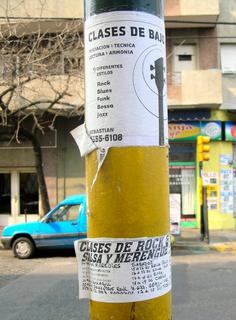 The morning class ended at 1 pm, and I was to meet my friend Leandro for lunch at 1:30. It was exhilirating again to be outside with the bike, in a city that I really love (with Buenos Aires, it was love at first sight, two years ago). The temperature was now about 60 (F), and the roads were still empty. But people were out on the street--sellers of fruits and vegetables; mothers strolling their infants and toddlers; men carting some goods; some people on bikes--it was a normal, pleasant city day, made that much more so by the relative lack of traffic. Once I had my camera out, I couldn't put it away, and took a number of photos, some of which I'll share here. To the left, you can see two notices posted on a pole. One is for lessons on the electric bass, and the sign indicates that the styles taught include "rock, blues, funk, bossa, and jazz." (I am trying to be a conscientious ethnomusicologist once again.) The lower poster advertises "clases de rock & roll, salsa y merengue." Other posters in the same area promoted other kinds of dance, including Arab, Afro, and Flamenco.
The morning class ended at 1 pm, and I was to meet my friend Leandro for lunch at 1:30. It was exhilirating again to be outside with the bike, in a city that I really love (with Buenos Aires, it was love at first sight, two years ago). The temperature was now about 60 (F), and the roads were still empty. But people were out on the street--sellers of fruits and vegetables; mothers strolling their infants and toddlers; men carting some goods; some people on bikes--it was a normal, pleasant city day, made that much more so by the relative lack of traffic. Once I had my camera out, I couldn't put it away, and took a number of photos, some of which I'll share here. To the left, you can see two notices posted on a pole. One is for lessons on the electric bass, and the sign indicates that the styles taught include "rock, blues, funk, bossa, and jazz." (I am trying to be a conscientious ethnomusicologist once again.) The lower poster advertises "clases de rock & roll, salsa y merengue." Other posters in the same area promoted other kinds of dance, including Arab, Afro, and Flamenco. 
Riding a bit further, I passed an area where a bunch of large posters for music concerts had been plastered. One of the more interesting ones you can see on the right. The heading says "Amparanoia"; I learned froma Google search that this is a Spanish group formed in Madrid in the mid-1990s, and they mix Folk, Mestizo, Reggae, Ska, and Bolero. You can learn more about them and hear their music at www.amparanoia.com/.
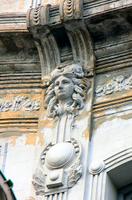 I also enjoyed, of course, just admiring the architecture of the city, filled with charming houses, elegant buildings, usually only a few stories high (except for the downtown business district near the river, where there are also some impressive skyscrapers) and lovely detail. But it was time for lunch, so I rode the rest of the way to the corner of Armenia and Santa Fe streets, to meet Leandro at the well-known restaurant Hermann, which specializes in the combination of foods that seem to be most favored here, meat, pasta, and wine.
I also enjoyed, of course, just admiring the architecture of the city, filled with charming houses, elegant buildings, usually only a few stories high (except for the downtown business district near the river, where there are also some impressive skyscrapers) and lovely detail. But it was time for lunch, so I rode the rest of the way to the corner of Armenia and Santa Fe streets, to meet Leandro at the well-known restaurant Hermann, which specializes in the combination of foods that seem to be most favored here, meat, pasta, and wine. 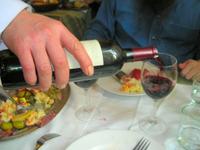 The photo on the right really tells it all. This was a Norton 2002 Tempranillo. It was recommended by the waiter, and it was indeed, an excellent choice, a rich, full-bodied red, which you can order at a restaurant in Buenos Aires for all of 15 pesos (US$5)--and not just for the glass, but for the bottle.
The photo on the right really tells it all. This was a Norton 2002 Tempranillo. It was recommended by the waiter, and it was indeed, an excellent choice, a rich, full-bodied red, which you can order at a restaurant in Buenos Aires for all of 15 pesos (US$5)--and not just for the glass, but for the bottle.As it is already approaching 3 AM, I will try to make the rest of this recounting of the past 24...well, now, 26 hours...relatively brief. My second lesson with Monica, between 6:30 and 8 pm, also went extremely well, I felt. When we began I was a bit tired, still reeling a bit from the after-effects of about 3/4 of a bottle of red wine (Leandro is a very moderate drinker God bless him), but by the end of the lesson I felt revived, and decided to take a taxi to meet Charles and A. at the Confiteria Ideal, where I could catch the last 2 hours of the late afternoon / early evening milonga. When I got there, it was full, and I wondered whether I would be able to dance. There was a bit of normal stage fright, but in the end, I'm not too shy, and soon I was dancing. It was certainly a challenge to navigate the crowded dance floor, although it wasn't as bad, I was told, as an hour earlier. By the end, and through the grace of the four different partners I was fortunate to dance with, I found ways to incorporate some of the elements of embrace, posture, rhythm, and pattern that I had learned in my classes in the past week. What a floor, what a space! Some find it a bit run down, but I agree with the napolitana dance partner with whom I shared a tanda that it is meraviglioso (a tanda is a sequence of three or four tangos that are played in a sequence; hopefully, you dance the full tanda with one partner). Charles was both complimenting my dancing, and pointing out small details in between the tandas, like a boxing coach in between rounds. "Always keep your head up, looking forward"; "make sure you don't lean forward to much"; "be confident--your dancing will reflect what you are feeling." He insists that I have to practice at the Ideal every afternoon, as a necessary part of my dance training. "That's where I learned to dance--dancing every afternoon at the Ideal." I'll have to listen to him, because today is his birthday. (Of course, I would listen to him anyway). Happy birthday, Charles!
Some more photos: 1. The lights of Corrientes Avenue, the Broadway of Buenos Aires, through a rainy taxi window, as it is moving.
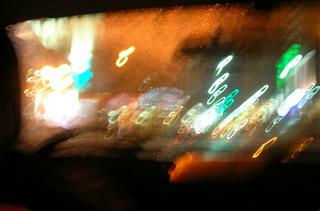
2. Los Productores, showing where Corrientes actually does meet Broadway

3. An image of the Confiteria Ideal, on Suipacha near the corner of Corrientes, where the age of elegance lives on...

After the milonga, we hailed a taxi, and Charles decided that we should head for the Brazilian restaurant on Mansilla in Palermo. We arrived there at around 11 pm, and ordered a muqueca de peixe with a side of vatapa. I found it happily ironic that I'd be spending my 24th hour in Buenos Aires, in a sense, back in Brazil. There was Zeca Pagodinho, promoting Skol beer; a map of Brazil showing all the different states in different colors; and on the TV was a talk show featuring one-time rival soccer stars Diego Maradona and Pele (in the image I caught here, you can see the no. 10 jerseys of the two Argentine and Brazil heroes displayed for the TV audience).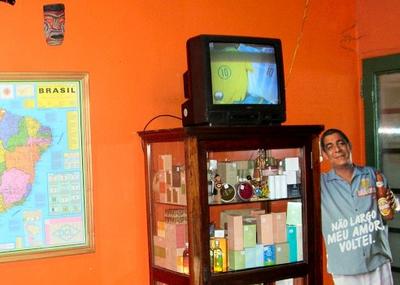 At around midnight, at the back of this small Bahian restaurant, couples were dancing samba de gafieira (a gafieira is a dance hall, and you dance the samba de gafieira as a couple dance, rather than as a solo display of foot skill). Charles of course, decided that he had to learn this, and he and A. went to the back and joined in. I starting chatting with Luiz, a gentleman who was dining with his grown children and their friends at the next table. We spoke in Portuguese. When I asked if he was from Buenos Aires, he said, "Não--eu sou um caipira de verdade," he said was a smile--"I'm a country hick!" He hailed from Lobos, in the hinterland of Buenos Aires province. In the tierra de gauchos, in fact--I recalled that there was a British documentary on gauchos that focused on people living around Lobos. Luiz said that the program had basically recreated a past that no longer existed. Luiz was a real gentleman, and a lover of Brazil. We conversed in Portuguese. He told me that just last week occurred the largest bank robbery in Brazil's history, in Fortaleza, the capital of Ceara. The robbers had bought a nearby property and had dug a tunnel (I have not gone to the web to confirm this story; I had not heard about it during my stay in Brazil; I only heard about massive robbery of state funds by politicians, something that people always talk of). I said to Luiz that this sounded like a story out of a film I had seen, a French film. "Ah, Rififi," he said. "It has a great whistling theme--it is the leitmotif of the film." I awarded Luiz an honorary doctorate in film music studies right on the spot. If you are reading this, Luiz, saludos!
At around midnight, at the back of this small Bahian restaurant, couples were dancing samba de gafieira (a gafieira is a dance hall, and you dance the samba de gafieira as a couple dance, rather than as a solo display of foot skill). Charles of course, decided that he had to learn this, and he and A. went to the back and joined in. I starting chatting with Luiz, a gentleman who was dining with his grown children and their friends at the next table. We spoke in Portuguese. When I asked if he was from Buenos Aires, he said, "Não--eu sou um caipira de verdade," he said was a smile--"I'm a country hick!" He hailed from Lobos, in the hinterland of Buenos Aires province. In the tierra de gauchos, in fact--I recalled that there was a British documentary on gauchos that focused on people living around Lobos. Luiz said that the program had basically recreated a past that no longer existed. Luiz was a real gentleman, and a lover of Brazil. We conversed in Portuguese. He told me that just last week occurred the largest bank robbery in Brazil's history, in Fortaleza, the capital of Ceara. The robbers had bought a nearby property and had dug a tunnel (I have not gone to the web to confirm this story; I had not heard about it during my stay in Brazil; I only heard about massive robbery of state funds by politicians, something that people always talk of). I said to Luiz that this sounded like a story out of a film I had seen, a French film. "Ah, Rififi," he said. "It has a great whistling theme--it is the leitmotif of the film." I awarded Luiz an honorary doctorate in film music studies right on the spot. If you are reading this, Luiz, saludos!
It was after midnight. We went out to find a taxi. Charles pointed out that the Salon Canning was nearby. The Monday night milonga there would be just getting hot around now. We smiled, and all realized that a good night's sleep is also a valued commodity.

3 Comments:
Great stuff. Between your words and your photos. You carry a camera very naturally, I always find a camera is a nag around my neck.
Terrific piece.
I almost can smell the South American coffee from here.
And talking beverages, South American wine is much like our Australian wine, it's sort of underappreciated. Aussies seem to good at making "big reds", the wine from over there I've tried from Chile is very similar.
And talking dancing there is a style I remember where an older gentleman dances with a very young lady which is particularly graceful. What is this style called? (Winter and Spring perhaps?)
Anyway, great post, good pictures. I think I've got another new favourite.
Thanks, Open Mind. I agree with you about the Australian reds. What I usually like to get at home (in the US), are Californias, Chileans, and Australians. The price:value ratio work for me with these. In Argentina, where I've been lucky to visit for the past 3 Augusts, just about any red one opens seems good. When my friend Leandro brought a Luigi Bosca Cabernet to me in Rio, in 2001, I thought that was the richest red I had ever had. Chocolatey, even. That one has never been surpassed. But I'm even more a beginning as a wine connoisseur than I am as a tango dancer. I'll try to find out if there is a term for the old man / young woman pairings...these were certainly in abundance at El Beso on Tuesday night. And I must say, most of those couples (they are couples on the dance floor, that is) looked great.
Post a Comment
<< Home